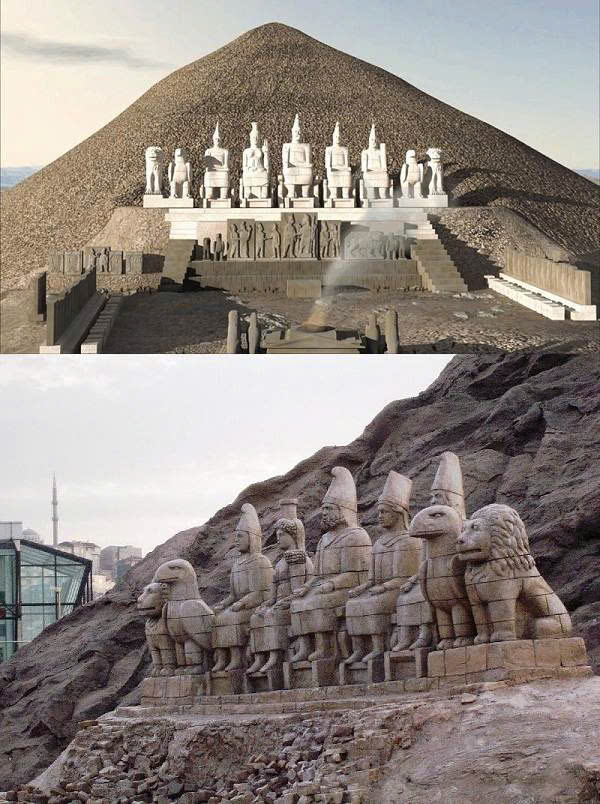Perched on the majestic slopes of Mount Nemrut in Adıyaman, Turkey, the Hierothesion stands as a monumental testament to the cultural richness and architectural ingenuity of the ancient Kingdom of Commagene. This UNESCO World Heritage site, dating back to the 1st century BCE, was conceived by King Antiochus I as a grand funerary complex and sanctuary. Blending artistic elements from Greek, Persian, and Anatolian traditions, the Hierothesion is not merely a resting place for a king—it is a vivid symbol of cultural synthesis and royal ambition. As one explores this ancient site, it becomes clear that it embodies far more than stone and sculpture; it tells the story of a unique kingdom seeking to unite diverse legacies into a singular identity.

Among the most striking and iconic features of the Hierothesion are its colossal statues, which dominate the three main terraces of the site. These terraces—eastern, western, and northern—are carefully arranged to reflect the spiritual and cultural values of Commagene society. On the eastern terrace, towering figures of Greek gods such as Zeus and Apollo stand as enduring reminders of the kingdom’s Hellenistic influences. Their majestic forms, carved with incredible attention to detail, reveal the reverence the Commagenians held for Greek mythology and its place within their religious framework. Intertwined with these Greek deities is the figure of Mithra, the Persian sun god, whose presence underscores the kingdom’s deep-rooted ties to Persian traditions. King Antiochus I himself appears in the lineup, carved with the same grandeur as the gods, illustrating his desire to be remembered not merely as a mortal ruler, but as a divine or semi-divine figure in the eyes of his people.
On the western terrace, equally imposing statues continue to narrate the cultural tapestry of Commagene. Here, the goddess Tyche, representing fortune and prosperity, stands alongside the famous “Lion Horoscope”—a unique and fascinating symbol that merges Anatolian and Mesopotamian iconography. This lion relief, thought by many scholars to represent a specific astrological event, hints at the kingdom’s sophisticated understanding of celestial phenomena and their integration into royal symbolism. Some of the statues on these terraces soar to heights of nearly 10 meters (approximately 33 feet), a feat that speaks volumes about the skill and ambition of the artisans who brought King Antiochus’s vision to life.
The arrangement of these monumental figures is far from arbitrary. Facing the eastern horizon, the statues are positioned to capture the first light of dawn, aligning with the rising sun in a way that suggests a deep awareness of astronomy. At an elevation of 2,150 meters (7,050 feet), Mount Nemrut provides an unparalleled vantage point for observing the heavens, and it is believed that this location was chosen specifically to enhance the sacred nature of the site. For the ancient Commagenians, the movement of celestial bodies held spiritual significance, and by aligning the Hierothesion with these cosmic rhythms, they imbued the site with a sense of divine order and cosmic connection.
In modern times, the Hierothesion continues to captivate scholars, archaeologists, and travelers alike. Efforts to preserve and understand the site have taken on new dimensions with the help of advanced digital technology. Researchers are using 3D scanning, virtual reality, and graphic modeling to reconstruct the site’s original grandeur, providing global audiences with immersive experiences that bring the ancient world to life. These virtual reconstructions allow for a detailed exploration of the site’s art and architecture, helping us understand the intentions behind its design and the values it sought to embody.
Through this blend of modern technology and ancient artistry, King Antiochus I’s grand vision for the Hierothesion is being rediscovered and shared with the world. The site’s careful balance of Greek elegance, Persian symbolism, and Anatolian tradition reveals a king who was not only a ruler but a cultural curator. He sought to create a lasting legacy that honored his diverse heritage while uniting his people under a shared identity. The Hierothesion is a physical manifestation of this ambition, its stones etched with the story of a kingdom at the crossroads of empires.
Today, the Hierothesion remains a powerful symbol of the enduring human drive to create, commemorate, and connect. It reflects how, even in times of political upheaval and uncertainty, civilizations have turned to monumental art and architecture to express their beliefs, assert their identity, and leave a legacy for future generations. The site stands as a poignant reminder that cultural exchange—far from diluting tradition—can enrich and elevate it, resulting in creations that transcend time and geography.
For visitors standing amidst the colossal ruins of Mount Nemrut, the experience is both humbling and inspiring. One cannot help but feel a connection to the ancient world, to the people who once climbed this mountain with devotion, who carved gods and kings from stone, and who looked to the skies for guidance and meaning. The Hierothesion, in all its grandeur and mystery, invites us to reflect on our own place within the vast continuum of history and to appreciate the cultural legacies that shape our present.
In preserving and studying the Hierothesion, we do more than safeguard stones—we honor a story of ambition, artistry, and unity in diversity. This remarkable site continues to speak to us across millennia, offering valuable lessons about heritage, innovation, and the shared human spirit that drives us to leave a mark on the world. Through the legacy of Mount Nemrut and its towering figures, we find a timeless expression of human creativity and cultural pride that continues to inspire wonder today.





